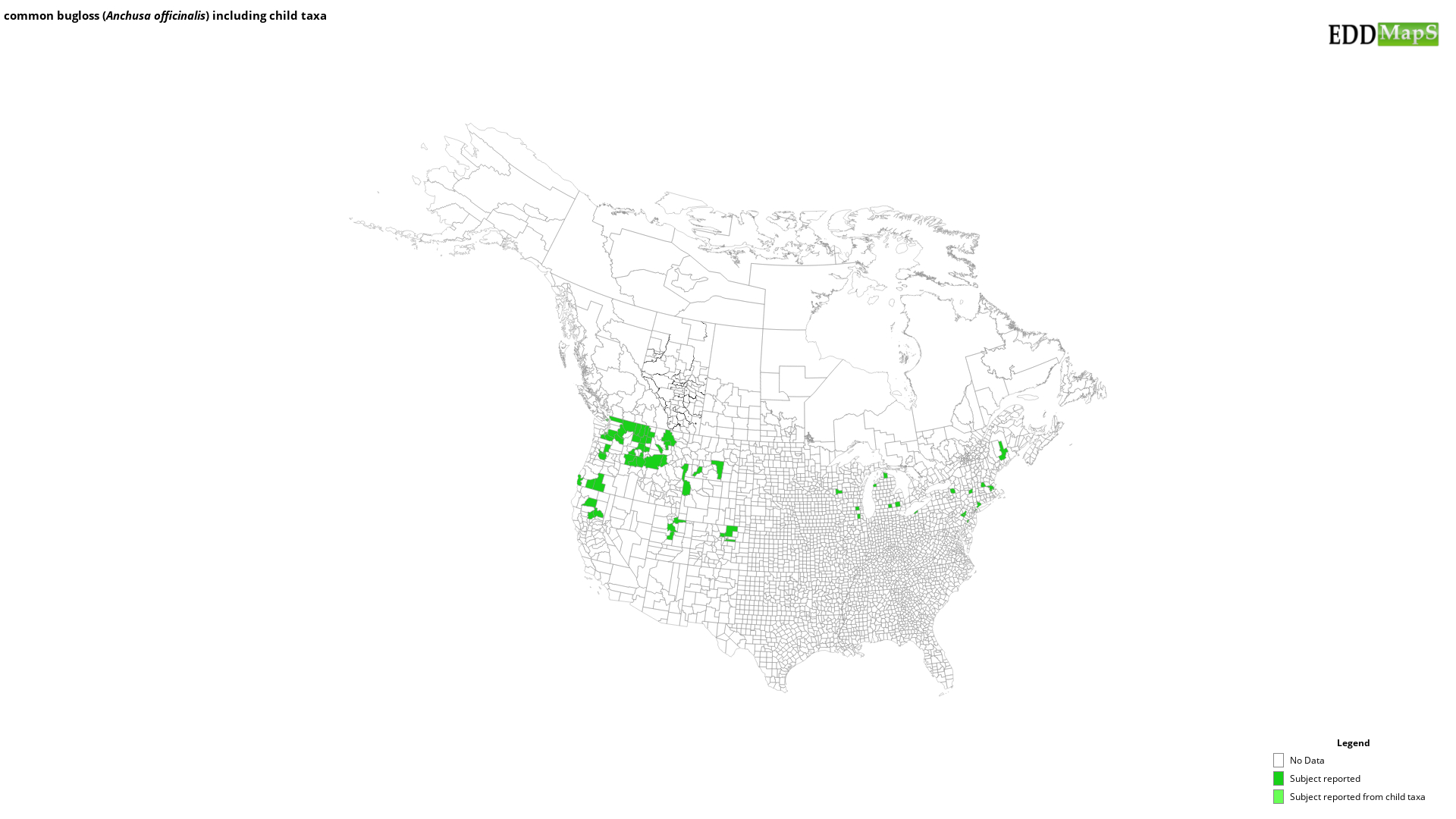common bugloss
(Anchusa officinalis)
This species is Introduced in the United States
Origin
Native to Eastern Europe and Western Asia.
Appearance
A. officinalis is a biennial to a perennial herb that can grow up to about 3′ (1 m) tall. Most parts of the plant are covered with white hairs. It has a long taproot.
Foliage
Hairy leaves are simple and alternate with one leaf per node along the stem. Margins are smooth. Leaves at the bottom of the plant have a stem while leaves at the top usually have no stem.
Flowers
The five petals are fused into a cuplike blue to purple flower. Flowers are reddish to start with changing to a blue-purple as it matures.
Fruit
Four chambered nutlet; each nutlet contains one seed. A plant can produce up to about 900 seeds.
Ecological Threat
It can tolerate sand, clay, chalk, or loam and can be found in disturbed sites such as meadows and fields. It does prefer moist but well-drained conditions.
Citations
Rawlins, K.A., R.L. Winston, C.T. Bargeron, D.J. Moorhead, and R. Carroll. 2018. New Invaders of the Northeast and Northcentral United States. USDA Forest Service, Forest Health Assessment and Applied Sciences Team, Morgantown, West Virginia. FHTET-2017-04. Retrieved from https://bugwoodcloud.org/resource/pdf/FHTET-2017-04_New%20Invaders_NE.pdf
Native to Eastern Europe and Western Asia.
Appearance
A. officinalis is a biennial to a perennial herb that can grow up to about 3′ (1 m) tall. Most parts of the plant are covered with white hairs. It has a long taproot.
Foliage
Hairy leaves are simple and alternate with one leaf per node along the stem. Margins are smooth. Leaves at the bottom of the plant have a stem while leaves at the top usually have no stem.
Flowers
The five petals are fused into a cuplike blue to purple flower. Flowers are reddish to start with changing to a blue-purple as it matures.
Fruit
Four chambered nutlet; each nutlet contains one seed. A plant can produce up to about 900 seeds.
Ecological Threat
It can tolerate sand, clay, chalk, or loam and can be found in disturbed sites such as meadows and fields. It does prefer moist but well-drained conditions.
Citations
Rawlins, K.A., R.L. Winston, C.T. Bargeron, D.J. Moorhead, and R. Carroll. 2018. New Invaders of the Northeast and Northcentral United States. USDA Forest Service, Forest Health Assessment and Applied Sciences Team, Morgantown, West Virginia. FHTET-2017-04. Retrieved from https://bugwoodcloud.org/resource/pdf/FHTET-2017-04_New%20Invaders_NE.pdf
Selected Images
Maps
EDDMapS Distribution - This map is incomplete and is based only on current site and county level reports made by experts, herbaria, and literature. For more information, visit www.eddmaps.org
State Lists - This map identifies those states that have this species on their invasive species list or law.
Invasive Listing Sources
Taxonomic Rank
| Domain: Eukarya |
| Kingdom: Plantae |
| Phylum: Magnoliophyta |
| Class: Magnoliopsida |
| Superorder: Asteranae |
| Order: Boraginales |
| Family: Boraginaceae |
| Genus: Anchusa |
| Anchusa officinalis |
References
Common Name Reference: USDA, NRCS. 2010. The PLANTS Database. National Plant Data Center, Baton Rouge, LA, USA.
Scientific Name Reference: USDA, NRCS. 2010. The PLANTS Database. National Plant Data Center, Baton Rouge, LA, USA.


